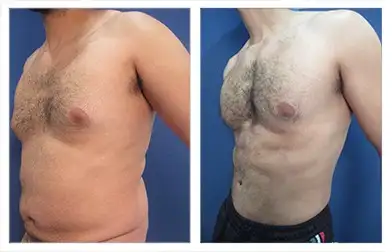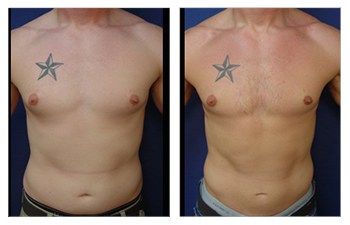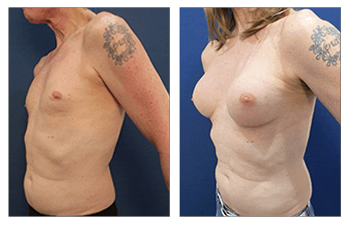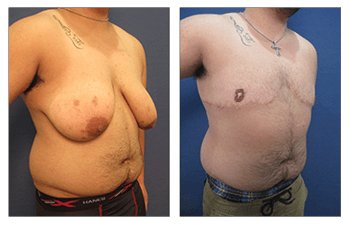WANT THE CONFIDENCE THAT COMES WITH
KNOWING YOU LOOK YOUR BEST?
Male breast surgery CASE STUDIES
Gender Breast Confirmation Surgery CASE STUDIES
Gender Breast Confirmation Surgery
Breast gender confirmation surgery refers to the ability to change the appearance of the patients' breasts to align with their gender preference. Length of hormone therapy and any breast changes resulting from being on hormones as well as your desired reassignment(male to female or female to male) will determine your ultimate surgical design.
Patients who are seeking a transformation from a male to a female are typically treated with breast augmentation surgery. Male patients desiring breast feminization are limited by the tightness of their skin as well as their short inframammary crease to nipple distance. This means that patients will have two options for surgery which include: 1)staged implant augmentation; 2)staged expander placement and implant augmentation. The former requires patients to be conservative with implant selection such that the nipple to inframammary crease distance matches the radius of their chosen implant. This ensures harmony of the chest appearance with a nipple that is centered on the newly created implant. A final modification of male breast augmentation also involves the placement of the implant over the muscle rather than under the muscles as done in female patients. This is because the male pectoralis muscle is much bulkier than the female pectoralis muscle and can result in dynamic deformities if the muscle is lifted to accommodate the more utilized subpectoral pocket. One year following augmentation, patients who desire more volume may have their implant replaced for a larger one once the skin between the nipple and inframammary crease has lengthened. The latter involves the placement of a lower profile expander which can be used to stretch out the skin over a three month period followed by expander removal and final implant placement. Stretching the lower breast pole skin allows for an increase in the nipple to inframammary crease distance which then will accommodate the desired implant size. If patients have been on hormones for extended periods, they may have developed some glandular tissue and lower breast pole lengthening thus avoiding the need for a staged procedure. In order to determine whether you can undergo a single-stage male to female transformation a breast sizing consultation is required.
Patients who are seeking a transformation from a female to a male are typically treated with a modified mastectomy. This procedure is done by truncating the female breast mound with a wedge excision. The wedge excision is performed with specific with a strategic straight line excision pattern so that the remaining skin and soft tissues create linear borders that are bold and pentagonal in shape. Frequently, tapered debulking of the central breast tissue is also performed in order to ensure that the chest is flat and masculinized.
Breast confirmation surgery has become a mainstay gender reassignment surgery and is often the initial gender change surgery. Both males to female and female to male surgeries provide consistently aesthetic results for patients interested in breast confirmation surgery.
Procedure
Gender breast confirmation surgery includes changing the gender identification appearance of the breast.
Length
1 hour of surgery is required for the female to male gender breast confirmation surgery; 2 hours for the male to female gender confirmation surgery.
Anesthesia
General anesthesia.
Place of Treatment
Outpatient surgical suite or hospital operating room.
Side Effects
Contour irregularities. Due to the drastic change in contour that is required to alter a patient's gender appearance, minimal contour irregularities are more frequent than routine contouring surgeries. For example in the male to female gender breast confirmation surgery, there might be lower breast pole tightness that alleviates with time as the inferior breast pole continues to stretch out. In the female to male gender breast confirmation surgery, all attempts are made to create straight-line chest borders. As incisions heal, they tend to "round out" which may compromise ideal straight-line borders.
Risks
Skin compromise following gender breast confirmation surgery may occur since a combination of excisional surgery as well as debulking liposuction may be required to alter the female to male gender breast appearance. When a combination of excisional and lipectomy procedures are used, the risk of vascular compromise is heightened. In male to female breast transformations, skin compromise may occur if an implant that is too large to be accommodated by an overlying tight breast skin is chosen.
Recovery
The recovery for gender breast confirmation surgery is approximately 1 to 2 weeks for the return to routine daily activities. In general, gender breast confirmation surgery patients may routine to full physical activity with no limitation by 1 month following surgery.
Duration of Results
Patients are universally pleased with gender breast confirmation surgery results as the breast contouring transformations are dramatic and permanent. Since breasts are vulnerable to the effects of gravity, patients will notice natural aging changes of the breast. As is generally with routine breast surgery, the larger the breasts, the more vulnerable the breasts will be to natural sagging; as such, male to female breasts are more likely to undergo drastic changes with time.
FREQUENTLY ASKED QUESTIONS
What does gender breast confirmation surgery involve?
Gender breast confirmation surgery involves a customized surgical plan intended to convert your gender breast appearance to your preference. Gender breast alteration may involve transformation from a male to a female breast or a female to a male breast. The goals of a male to female breast transformation involve increasing overall breast mound fullness and roundedness; moderate increases in size may be achieved with a single surgery but more prominent increases in breast size do require a staged procedure. The female to male breast transformation may be achieved using a modified wedge excision mastectomy procedure in order to create a flatter and more straight-line bordered pentagonal shaped breast appearance.
Am I a good candidate for gender breast confirmation surgery?
Any and all patients who desire gender reidentification may be excellent candidates for gender breast confirmation surgery. Most patients seeking gender breast alteration surgery have typically undergone counselling and are typically on hormone replacement therapy well in advance of any gender changing breast surgery. If patients have been on prolonged hormone replacement therapy, they will typically require less surgical intervention to alter breast gender appearance.
How do I plan for my gender breast confirmation surgery?
Gender breast confirmation surgery requires a commitment to postoperative recovery. Since general anesthesia is required, 1 to 2 days of assistance is required by a responsible adult to ensure that the effects of anesthesia resolve. Patients should also get generalized help around the house if heavy lifting, pushing, or pulling is expected.
How do I prepare for gender breast confirmation surgery?
Whether you are undergoing male to female or female to male breast transformation, this is major surgery and requires optimization of your healing potential. Patients are asked to maximize their daily protein intake by consuming 150grams of protein daily. Patients are also advised to avoid any blood thinners. Finally, ALL smoking must be stopped at least one month prior to surgery to optimize healing of skin incisions and minimize the risk of infection especially for a male to female transformations requiring placement of breast implants.
What results can I expect after gender breast confirmation surgery?
Gender breast confirmation surgery involves the creation of dramatic changes in contour that portray the change of a female to a male breast or male to the female breast. Female to male breast changes will demonstrate a transformation from a more feminized appearance of a fuller and rounder breast to a flat, yet bold armor plate chest appearance; in contrast, male to female breast changes will demonstrate a transformation of their flat chests to a more robust and rounded feminized breast appearance.
Where will my gender breast confirmation surgery be performed?
Your gender confirmation surgery will be performed at one of our accredited surgery centers. Due to the invasive nature of the surgery, patients require general anesthesia.
What type of anesthesia will be used for my gender breast confirmation surgery?
Your gender breast confirmation surgery will be performed while under general anesthesia. General anesthesia is recommended to you since breast surgery involves surgical incisions and dissections through the chest region that has a high density of nerve fibers.
What should I expect after gender breast confirmation surgery?
When you wake up from surgery, you will find your breasts wrapped with a compression dressing wrap. This wrap will prevent bruising and swelling but also minimize pain by virtue of activating pressure nerves that will overpower pain nerve transmission.
When will I be able to return to work following gender breast confirmation surgery?
Patients who undergo gender breast confirmation surgery will require 1 week to return to routine daily activities. Patients are allowed to participate in below the waist workouts at 2 weeks but will have to wait a full month before being allowed to perform all physical activities without any limitations.
PATIENT-SPECIFIC QUESTIONS
Why can you not perform a male to female breast transformation surgery with a single surgery and desired implant size?
When it comes to breast implant augmentation surgery, it is critical to appreciate two rules. The first, the implant must sit on the inframammary crease; in fact, it is the crease that supports the implant weight and prevents it from slipping down into the abdomen, termed bottoming out. The second, the implant must be centered on the nipple and areola complex; If you do some elementary geometry, you will recognize that the implant radius should equal the distance between the nipple and the inframammary crease. Since the nipple complex positioned lower on most males, this limits the size of the implant that can be used at the initial surgery.
What is the difference between routine breast implant augmentation and one that is performed for gender breast confirmation surgery?
The major difference between routine breast implant augmentation and one that is performed during gender breast confirmation surgery is the placement position of the implant. Breast implant augmentation generally requires placement of the breast implant in a subpectoral position. This placement minimizes the risk of thickened scar creation which may result in breast firmness, called capsular contracture. However, this placement is avoided in female patients who participate in physical fitness competitions since they have a more prominent pectoralis muscle. The reason for this is that when the pectoralis muscle has flexed a deformity, termed dynamic deformity, is created by virtue of these patients having thicker muscles. A similar situation occurs in males desiring gender reassignment breast surgery. Their muscles are often too prominent and they risk a dynamic deformity if the pectoralis muscle is released for a subpectoral pocket. As such, male to female breast transformations are performed with placement of the implant above the muscle, termed sub-glandular breast augmentation.
How does mastectomy for the patient with breast cancer differ from the mastectomy performed for gender breast reassignment surgery?
When performing traditional mastectomy, the breast soft tissues are removed using a transverse incision but all breast skin is preserved. When performing gender confirmation breast surgery, a strategic wedge excision of the lower breast tissues is performed with the purpose of eliminating both soft tissues and the overlying redundant skin in an attempt to masculinize the breast by creating a flat chest. The excision of the breast skin and soft tissues is designed to create linear borders in a pentagonal shape













